Abstract
Research on cellulose and its derivatives as biosensors is developing rapidly through the innovation and improvement of materials, chemical synthesis, and methods of preparation and formulation. This study presents the state of the art by introducing what has been innovated and patented concerning cellulose-based biosensors between 2010 and 2020. More specifically, this form of patent analysis encapsulates information that could be used as a reference by researchers in the fields of biosensors and cellulose-based biosensing platforms, as well as those interested especially in cellulose and its derivatives. As a result of this study, a total of 241 patent documents related to cellulose-based biosensors were found. The United States leads the patent race in this sector. Based on patent classifications, most patents and inventions are intended for chemical analysis of biological materials and testing involving biospecific ligand binding methods, as well as measuring or testing apparatus with condition measuring or sensing means. Research and development are based on the investigating or analyzing of materials by the use of electric or electrochemical means, as well as nanotechnology for interacting, sensing, or actuating, which are concentrated in most patents.
1. Introduction
Materials used for fabricating biomedical devices, such as implantable biosensors, need to possess appropriate physical, chemical, and biological properties, depending on specific circumstances [1]. Among a variety of materials commonly used as biosensing platforms, cellulose and its derivatives have gained considerable attention [2,3].
Cellulose and its derivatives exhibit biologically appropriate properties which make them suitable for biomedical applications [4,5,6]. Due to its promising physical and biological characteristics as well as chemical structure, cellulose has been shown to be a multifunctional material, providing a high-quality platform to complete the immobilization process of bioactive molecules in biosensors [7]. Nevertheless, some researchers have investigated methods to improve cellulose properties to meet biosensing requirements and then facilitate the applicability of cellulose in biosensing [2,8].
The first patent application concerning cellulose-based biosensors was filed in 1987 and then granted in 1991 [9]. Through this patent, Godfrey invented methods of producing suitable polymers for use as optical structures. More specifically, the inventor proposed new ways of applying an optical coating to the surface of a polymer-coated structure to make surfaces suitable for use in biosensors. A claimed method in this patent suggested that the polymer was cellulose nitrate [9].
Research on cellulose and its derivatives as biosensors is developing rapidly through the innovation and improvement of raw materials, chemical synthesis, and methods of preparation and formulation, with more than 200 organizations around the world currently involved in patent activity and filings concerning cellulose-based biosensors. This trend is supported by cellulose’s numerous advantages in biosensing and biomedical applications. This is also evident from the increase in the number of patent applications filed each year worldwide in the field of cellulose-based biosensor research and development [10].
This study, in the form of patent analysis, presents the state of the art by introducing what has been patented in relation to cellulose-based biosensors between 2010 and 2020. Furthermore, detailed charts have been provided by determining publication year, classifications, inventors, applicants, owners, and jurisdictions. Finally, a selection of relevant granted patents and patent applications is proposed to demonstrate the innovation and improvement of these cellulose-based biosensors.
2. Methods
2.1. Resources and Research Methods
Two databases have been used in this study: the Patentscope search service of the World Intellectual Property Organization (WIPO) [10,11] and The Lens patent data set [12]. Different keywords related to cellulose-based biosensors were used, and patent documents were searched according to title, abstract, and claims. The results were then filtered to include only patent documents with a publication date between 1 January 2010 and 31 December 2020.
2.2. Analysis of the Patentability of Cellulose-Based Biosensors
As a result of the search, 241 patent documents were found. Generally, this encompassed patent applications and granted patents. In relation to cellulose-based biosensors, the found patent documents have been classified as 204 patent applications and 37 granted patents. The detailed list of these patent documents is presented in Table S1 (Supplementary Materials).
Hereinafter, the state of the art will be reviewed by introducing what has been patented concerning cellulose-based biosensors. A detailed analysis of the patentability will be provided, with emphasis on the used cellulose and its derivatives, testing involving biospecific ligand binding methods, and interacting, sensing, or actuating, following the publication year, patent classifications, inventors, applicants, owners, and jurisdictions.
3. Results and Discussion
3.1. Publication Year
The publication year is the year in which a patent document (i.e., patent application, granted patent, etc.) was published and made available to the public [13].
Concerning cellulose-based biosensors, our search found 241 patent documents between 2010 and 2020. The results encompassed 204 patent applications and 37 granted patents. Our search found five registered patent documents for the year 2010. In contrast, the year 2020 recorded 34 patent documents. The maximum number of granted patents (eight) was recorded in 2018. Furthermore, the year 2020 was the year with the maximum patent applications or patent documents, with 27 and 34, respectively, (Figure 1).
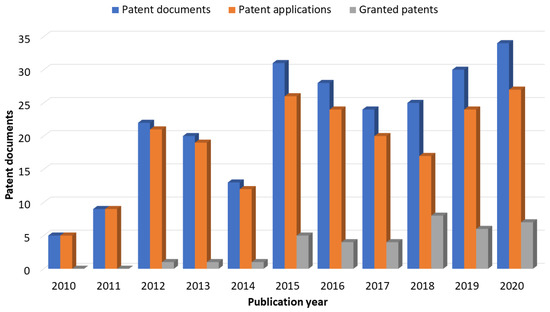
Figure 1.
Evolution of patent documents (i.e., patent applications and granted patents) as a function of the published date of cellulose-based biosensors between 2010 and 2020.
3.2. Patent Classifications
The International Patent Classification (IPC) is a code-based hierarchical system that separates all technological domains into sections, classes, subclasses, groups, and subgroups. It is a global classification system that provides standardized data for categorizing inventions and assessing their technological distinctiveness [14,15].
Concerning cellulose-based biosensors, the top 10 IPC codes between 2010 and 2020 are presented in Figure 2. The most-recorded IPC code corresponds to G01N27/327, which is a subgroup of investigating or analyzing materials by the use of electric or electrochemical means, such as biochemical electrodes. This subgroup alone recorded 60 patent documents. The second most-recorded IPC code corresponds to C12Q1/00, which is a group of measuring or testing processes involving enzymes, nucleic acids, or microorganisms. It concerns measuring or testing apparatus with condition-measuring or sensing means. This group has 45 recorded patent documents. For more details concerning this top 10, a description of each IPC code is shown in Table 1.
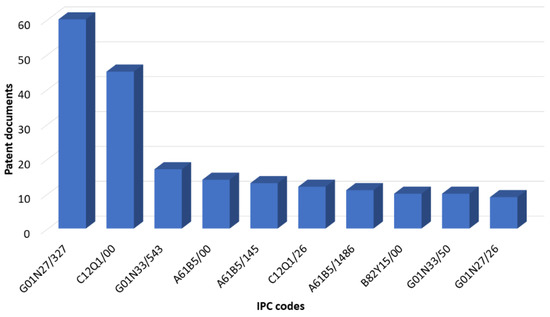
Figure 2.
IPC codes (top 10) of the resulted patents as a function of patent documents of cellulose-based biosensors between 2010 and 2020.

Table 1.
Meaning of IPC codes concerning the resultant patents of cellulose-based biosensors [14].
3.3. Inventors
An inventor is a natural person designated for a patent application [13].
Concerning cellulose-based biosensors, the top 10 inventors between 2010 and 2020 are presented in Figure 3. Jung Sung-Kwon from the Republic of Korea is ranked as the first inventor who has recorded 15 patent documents. The inventors Cha Geun Sig and Nam Hakhyun, from the Republic of Korea, tied for second place with 11 patent documents each.
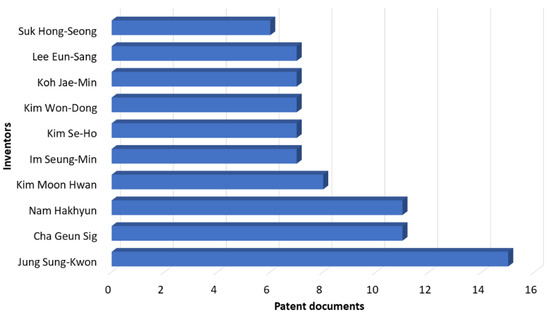
Figure 3.
Inventors (top 10) of the resulted patents as a function of patent documents of cellulose-based biosensors between 2010 and 2020.
All found patent documents by the above three inventors concern the healthcare companies i-Sens Inc., (Seoul, Republic of Korea) and Osang Healthcare Co. Ltd., (Dongan-gu Anyang, Republic of Korea) as applicants and/or owners (Figure 4 and Figure 5). i-Sens Inc. is a healthcare company that develops, produces, and distributes medical devices. The company’s main products include blood glucose monitoring systems, electrolyte and gas analyzers, and immunosensors [16]. However, Osang Healthcare Co. Ltd. is a healthcare company that manufactures and distributes medical supplies. The company produces diagnostic biosensors for blood glucose measurements, cholesterol-measuring devices, and other related products [17].
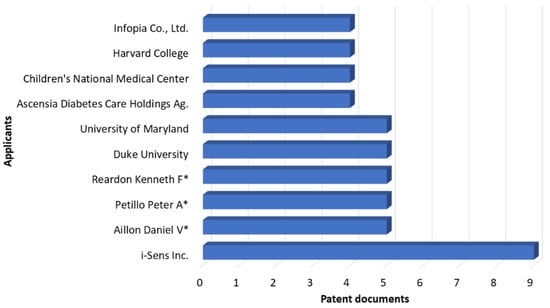
Figure 4.
Applicants (top 10) of the resulted patents as a function of patent documents of cellulose-based biosensors between 2010 and 2020. * The applicant is a natural person.
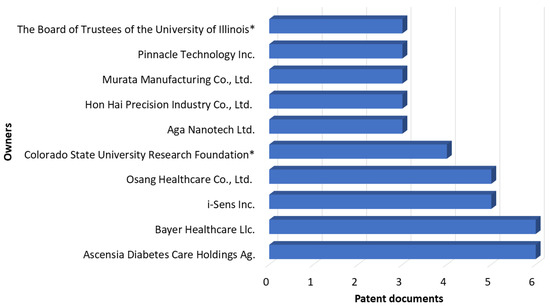
Figure 5.
Owners (top 10) of the resulted patents as a function of patent documents of cellulose-based biosensors between 2010 and 2020. * The owner is a foundation or a governing body.
3.4. Applicants
In the case of a patent application, an applicant is a natural person or a legal entity that has filed the application [13].
Concerning cellulose-based biosensors, the top 10 applicants between 2010 and 2020 are presented in Figure 4. Regarding this top 10, all applicants are considered as people or organizations (companies and universities). As a legal entity, the healthcare company i-Sens Inc. (Seoul, Republic of Korea) is ranked as the first applicant that has recorded nine patent documents.
3.5. Owners
An owner is a natural person or a legal entity to whom the inventor or applicant has assigned the right to a patent [18,19].
Concerning cellulose-based biosensors, the top 10 owners between 2010 and 2020 are presented in Figure 5. The healthcare companies Ascensia Diabetes Care Holdings Ag. (Basel, Switzerland) and Bayer Healthcare Llc. (Emeryville, CA, USA), as legal entities, are ranked as the first owners who have recorded 6 patent documents each.
3.6. Jurisdictions
A patent application can be filed at the appropriate patent office under whose jurisdiction the applicant normally resides, has his domicile, or has a place of business, or at the place from where the invention actually originated. In several cases, related patent applications can be filed in multiple jurisdictions [20,21].
Concerning cellulose-based biosensors, the top 10 jurisdictions between 2010 and 2020 are presented in Figure 6. The United States, through the USPTO (United States Patent and Trademark Office), encompassed 110 patent documents with a higher patent contribution per total of ~46%; the global system for filing patent applications, known as the Patent Cooperation Treaty (PCT) and administered by WIPO, encompassed 73 patent documents with a patent contribution per total of ~30%; China, through the CNIPA (China National Intellectual Property Administration), encompassed 27 patent documents with a patent contribution per total of ~11%; finally, the EPO (European Patent Office), through which patent applications are filed regionally (Europe), encompassed 23 patent documents with a patent contribution per total of ~10%.
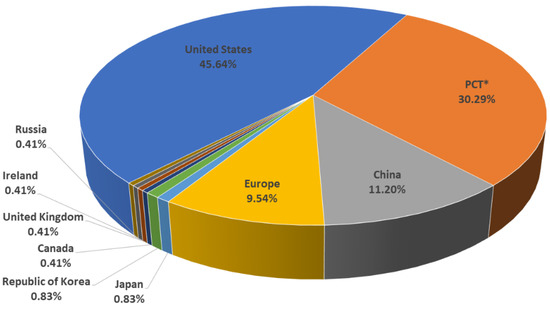
Figure 6.
Patent contribution (%) as a function of jurisdiction of filed patent applications and granted patents of cellulose-based biosensors between 2010 and 2020. * The global system for filing patent applications, known as the Patent Cooperation Treaty (PCT) and administered by WIPO.
4. Selection of Relevant Patents
Cellulose-based biosensors are a technological innovation in the field of nanotechnology for sensing and analyzing by the use of electrochemical means. These cellulose-based biosensors are developing rapidly through the improvement of materials, chemical synthesis, and methods of preparation and formulation.
Table 2 presents examples of innovation and utilization of cellulose-based biosensors as demonstrated by inventions and patents. To clarify the real status of such patents in this area, the ones described herein are the most relevant patents focused on cellulose-based biosensors between 2010 and 2020. The choice of these selected patent documents was based on the most prolific countries patenting cellulose-based biosensors, as well as the patenting levels (national, regional, and international). However, the detailed list of all patent documents is presented in Table S1 (Supplementary Materials).

Table 2.
Selection of relevant patents for cellulose-based biosensors between 2010 and 2020.
In 2010, Baker, et al., invented a novel sensor mechanism based on the aggregation of nanoparticles for target molecule detection and quantification. The signal-enhanced biosensor system, according to this patent, was made with a substrate that was selected from a group consisting of, among other things, a cellulose substrate or a nitrocellulose substrate [22].
In 2012, Kim invented a disposable biosensor made of tin oxide-cellulose nanocomposite. The invented biosensor was biodegradable, biocompatible, and flexible. It was obtained by coating tin oxide on the surface of a regenerated cellulose film and fixing the biochemical receptor (e.g., glucose oxidase, glutaminase, asparaginase, penicillinase, nitrate reductase, etc.) by a conventional method, such as encapsulation, covalent binding, crosslinking, and adsorption [23].
In 2013, Wilsey invented a method for determining the concentration of glucose in a blood sample by using sample volumes of less than a microliter, and test times within about eight seconds of the application of the sample. The invention is related to an electrochemical sensor comprising an array of micro-electrodes disposed on a flexible substrate. The sensor includes a chemical coating made up of a binder and contains a set of chemicals (e.g., methylcellulose, hydroxyethylcellulose, carboxymethylcellulose, microcrystalline cellulose, etc.) that react to produce an electroactive reaction product [24].
In 2015, Jeon, et al., invented a reagent composition for a biosensor having high sensitivity, which is capable of improving analysis linearity and detecting the concentration of a small amount of the analyte, such as glucose, by reacting with an oxidoreductase. The invented biosensor reagent composition, according to patent claims, encompasses, amongst other ingredients, a water-soluble polymer such as hydroxyethyl cellulose, hydroxypropyl cellulose, carboxy methyl cellulose, and cellulose acetate [25].
In 2018, Agarwal, et al., invented a biosensor for detecting the presence of a target analyte in a sample. Disclosed in the patent is a biosensor device for the real-time detection of a target analyte that includes a receptor component operatively connected to a transducer component which is adapted to interpret and transmit a detectable signal. The claimed biosensor uses a sensing element that comprises a polymer and was selected from a group consisting of, among others, carboxymethyl cellulose and derivatives [26].
In 2020, Pu et al., invented a flexible skin electrochemical biosensor based on a conductive, cellulose-based hydrogel. The newly invented biosensor comprised a reference electrode, a counter electrode, a working electrode, and a signal wire, which were arranged on the conductive hydrogel film substrate layer. The formulation of the conductive hydrogel film substrate layer comprised mixing a zwitterionic polymer monomer, a nano-cellulose solution, a thermal initiator, and a crosslinking agent. The working electrode was used for measuring biomolecules, and the signal wire was connected to external equipment. The invention improved the requirements for target molecule detection performance and wearing comfort [27].
5. Conclusions
This study provided patentability and patent analysis of cellulose-based biosensors. The detailed analysis concerned the period between 2010 and 2020. The publication year, 2020, was the year with the highest patent registration, with 34 patent documents. The United States was ranked first with 110 patent documents. Based on the IPC codes, all filed patents concerned chemical analysis of biological materials, and testing involving biospecific ligand binding methods, as well as measuring or testing apparatus with condition-measuring or sensing means. In addition, this study demonstrated that the inventions included in the patents concerned cellulose formulation and the process for preparing it, as well as devices and apparatus for manufacturing cellulose-based biosensors. The knowledge clusters and expert driving factors of this patent analysis indicate that the research and development were based on the investigating or analyzing of materials by the use of electric or electrochemical means, as well as nanotechnology for interacting, sensing, or actuating, which was concentrated in most patents.
Supplementary Materials
The following supporting information can be downloaded at: https://www.mdpi.com/article/10.3390/IECB2022-12253/s1, Table S1: Detailed list of all patent documents of cellulose-based biosensors between 2010 and 2020.
Funding
This research received no external funding.
Institutional Review Board Statement
Not applicable.
Informed Consent Statement
Not applicable.
Data Availability Statement
The data presented in this study are available within this article content.
Acknowledgments
The author acknowledges the World Intellectual Property Organization for the Patentscope search service and the Cambia Institute for The Lens patent data set used in this study.
Conflicts of Interest
The author declares that the content of this article has no conflict of interest. The author has no relevant affiliations or financial involvement with any organization or entity with a financial interest in or financial conflict with the subject matter or materials discussed in this article.
References
- Bhalla, N.; Jolly, P.; Formisano, N.; Estrela, P. Introduction to biosensors. Essays Biochem. 2016, 60, 1–8. [Google Scholar] [CrossRef] [PubMed] [Green Version]
- Esmaeili, C.; Abdi, M.M.; Mathew, A.P.; Jonoobi, M.; Oksman, K.; Rezayi, M. Synergy Effect of Nanocrystalline Cellulose for the Biosensing Detection of Glucose. Sensors 2015, 15, 24681–24697. [Google Scholar] [CrossRef] [PubMed] [Green Version]
- Montañez, M.I.; Hed, Y.; Utsel, S.; Ropponen, J.; Malmström, E.; Wågberg, L.; Hult, A.; Malkoch, M. Bifunctional Dendronized Cellulose Surfaces as Biosensors. Biomacromolecules 2011, 12, 2114–2125. [Google Scholar] [CrossRef] [PubMed]
- Fatimi, A.; Axelos, M.A.V.; Tassin, J.F.; Weiss, P. Rheological Characterization of Self-Hardening Hydrogel for Tissue Engineering Applications: Gel Point Determination and Viscoelastic Properties. Macromol. Symp. 2008, 266, 12–16. [Google Scholar] [CrossRef]
- Fatimi, A.; Tassin, J.F.; Quillard, S.; Axelos, M.A.; Weiss, P. The rheological properties of silated hydroxypropylmethylcellulose tissue engineering matrices. Biomaterials 2008, 29, 533–543. [Google Scholar] [CrossRef] [PubMed] [Green Version]
- Fatimi, A.; Tassin, J.F.; Turczyn, R.; Axelos, M.A.; Weiss, P. Gelation studies of a cellulose-based biohydrogel: The influence of pH, temperature and sterilization. Acta Biomater. 2009, 5, 3423–3432. [Google Scholar] [CrossRef] [PubMed] [Green Version]
- Kamel, S.A.; Khattab, T. Recent Advances in Cellulose-Based Biosensors for Medical Diagnosis. Biosensors 2020, 10, 67. [Google Scholar] [CrossRef] [PubMed]
- Deshpande, S.D.; Kim, J.; Yun, S.-R. Studies on conducting polymer electroactive paper actuators: Effect of humidity and electrode thickness. Smart Mater. Struct. 2005, 14, 876–880. [Google Scholar] [CrossRef]
- Godfrey, R.E. Polymer-Coated Optical Structures and Methods of Making and Using the Same. Granted Patent US 4992385 A; Washington, DC, USA, 12 February 1991. [Google Scholar]
- World Intellectual Property Organization. The Patentscope. Available online: https://patentscope.wipo.int (accessed on 2 December 2021).
- World Intellectual Property Organization. Patentscope Fields Definition. Available online: https://patentscope.wipo.int/search/en/help/fieldsHelp.jsf (accessed on 2 December 2021).
- Cambia Institute. The Lens Patent Data Set. Version 8.0.14. Available online: https://www.lens.org (accessed on 2 September 2021).
- European Patent Office. Espacenet Glossary. Version 1.24.1. Available online: https://worldwide.espacenet.com/patent (accessed on 2 December 2021).
- World Intellectual Property Organization. IPC Publication. IPCPUB v8.5. Available online: https://www.wipo.int/classifications/ipc/ipcpub (accessed on 2 December 2021).
- World Intellectual Property Organization. Guide to the International Patent Classification (IPC). Available online: https://www.wipo.int/edocs/pubdocs/en/wipo_guide_ipc_2020.pdf (accessed on 2 December 2021).
- Bloomberg. i-Sens Company Profile. Available online: https://www.bloomberg.com/profile/company/099190:KS (accessed on 5 January 2022).
- Bloomberg. Osang Healthcare Company Profile. Available online: https://www.bloomberg.com/profile/company/036220:KS (accessed on 5 January 2022).
- World Intellectual Property Organization. What is Intellectual Property? Frequently Asked Questions: Patents. Available online: https://www.wipo.int/patents/en/faq_patents.html (accessed on 2 September 2021).
- United States Patent and Trademark Office. Manual of Patent Examining Procedure: Ownership/Assignability of Patents and Applications. Available online: https://www.uspto.gov/web/offices/pac/mpep/mpep-0300.html (accessed on 13 December 2021).
- Fatimi, A. Patent landscape analysis of hydrogel-based bioinks for 3D bioprinting. Mater. Proc. 2021, 7, 3. [Google Scholar] [CrossRef]
- Fatimi, A. Patentability of biopolymer-based hydrogels. Mater. Proc. 2021, 3. [Google Scholar] [CrossRef]
- Baker, C.O.; Behrenbruch, C.; Rahib, L. Functionalized Polymer Biosensor. Patent WO 2010124270 A1; PCT, Seattle, WA, USA, 28 October 2010. [Google Scholar]
- Kim, J.H. Disposable Biosensors Made with Tin Oxide—Cellulose Nanocomposite, Manufacturing Method of the Same and Measuring Method Using the Same. Patent KR 20120050359 A; Korea, 18 May 2012. [Google Scholar]
- Wilsey, C.D. Determination of Blood Glucose in a Small Volume and in a Short Test Time Using a Chemical Coating Including Binders and Very Short Read Potentials. Granted Patent US 8349168 B2; USA, 11 December 2012. [Google Scholar]
- Jeon, S.-I.; Jung, S.-K.; Im, S.-M.; Lee, E.-S.; Kim, S.-H.; Suk, H.-S.; Kim, W.-D.; Koh, J.-M. Reagent Composition for Biosensor and Biosensor Having the Same. Patent EP 2821497 A2; Europe, 7 January 2015. [Google Scholar]
- Agarwal, A.K.; Goel, V.K.; Kim, D.-S.; Lin, B. A Biosensor Device to Detect Target Analytes In Situ, In Vivo, and/or in Real Time, and Methods of Making and Using the Same. Patent US 20180271423 A1; Toledo, OH, USA, 27 September 2018. [Google Scholar]
- Pu, Z.; Li, C.; Li, D. Flexible Epidermal Electrochemical Biosensor Based on Conductive Hydrogel. Patent CN 111839532 A; Tianjin, China, 30 October 2020. [Google Scholar]
Publisher’s Note: MDPI stays neutral with regard to jurisdictional claims in published maps and institutional affiliations. |
© 2022 by the author. Licensee MDPI, Basel, Switzerland. This article is an open access article distributed under the terms and conditions of the Creative Commons Attribution (CC BY) license (https://creativecommons.org/licenses/by/4.0/).